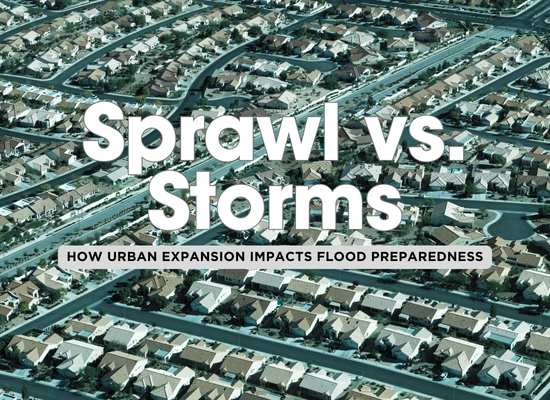🌧️ “When Growth Becomes a Threat”
Urban sprawl, the rapid expansion of cities into surrounding areas, is reshaping landscapes worldwide. While it fuels economic growth and meets the demand for housing, it comes with hidden dangers—one of the most pressing being an increased risk of flash floods.
As natural landscapes are replaced by concrete and asphalt, the ability of the ground to absorb rainwater diminishes, leading to sudden and destructive flooding. In this three-part series, we’ll explore how urban sprawl exacerbates flash flood risks, the environmental consequences, and the innovative solutions being adopted to combat this growing problem.
How Urban Sprawl Increases Flash Flood Risks
🏙️ “Concrete Jungles and Water Runoff”
Urban sprawl transforms once-porous landscapes into impermeable surfaces, dramatically altering how rainwater behaves. With fewer natural areas to absorb precipitation, stormwater accumulates quickly, leading to flash floods that can devastate urban areas.
Key Drivers of Increased Flash Flood Risks
- Loss of Natural Absorption
- The Problem: Natural landscapes like forests and wetlands act as sponges, absorbing rainwater and slowing its flow. Urban sprawl replaces these areas with buildings, roads, and parking lots, which are impermeable and force water to run off rather than soak in.
- The Impact: This runoff overwhelms drainage systems, causing water to pool in low-lying areas, often within minutes of heavy rainfall.
- Overloaded Stormwater Systems
- The Problem: Existing drainage systems in expanding cities are often outdated or undersized for the increased runoff.
- The Impact: During intense rainfall, these systems fail to channel water away quickly enough, leading to street flooding and property damage.
- Channelized Waterways
- The Problem: Urban areas often replace natural streams with concrete channels to manage water flow.
- The Impact: While this speeds up water movement, it increases the likelihood of downstream flooding by concentrating water in narrower pathways.
- Increased Urban Heat Island Effect
- The Problem: Urban sprawl raises temperatures in cities, causing more intense rainstorms as warm air holds more moisture.
- The Impact: Heavier rainfall means more water to manage, amplifying the risk of flash floods.
Case Study: Houston, Texas
- What Happened: Rapid urban sprawl and loss of wetlands in Houston have significantly increased the city’s vulnerability to flash floods. During Hurricane Harvey in 2017, the city faced catastrophic flooding partly due to its vast impermeable surfaces.
- Lesson Learned: Preservation of natural landscapes and investments in green infrastructure are critical to mitigating such risks.
Practical Insights for Urban Planning
- Emphasize Green Spaces: Incorporate parks, rain gardens, and permeable pavements in city planning to reduce runoff.
- Upgrade Drainage Systems: Ensure stormwater infrastructure matches the pace of urban expansion.
- Preserve Natural Buffers: Protect wetlands, forests, and floodplains to maintain their natural absorption capacity.
Urban sprawl may be inevitable, but its impact on flash flood risks can be managed. By understanding the relationship between impervious surfaces and water flow, cities can adopt smarter planning strategies to mitigate these dangers.
Environmental Consequences of Flash Floods in Urban Areas
🌊 “When Cities Drown: The Ecological Fallout”
Flash floods in urban settings do more than disrupt daily life; they inflict significant environmental damage that can have lasting effects on ecosystems and human health. The rapid influx of water overwhelms natural and man-made systems, leading to soil erosion, water contamination, and habitat destruction.
Key Environmental Impacts
- Soil Erosion and Sedimentation
- The Problem: Intense floodwaters erode topsoil, transporting sediments into waterways.
- The Impact: This process degrades soil quality, reduces agricultural productivity, and leads to sedimentation in rivers and streams, which can alter water flow and harm aquatic habitats.
- Water Contamination
- The Problem: Floodwaters often carry pollutants, including sewage, chemicals, and debris, into water supplies.
- The Impact: Contaminated water poses serious health risks to urban populations, leading to waterborne diseases and compromising the safety of drinking water sources.
- Habitat Destruction
- The Problem: Natural habitats within urban areas, such as parks and green spaces, can be devastated by flash floods.
- The Impact: The loss of vegetation and disruption of local wildlife can lead to decreased biodiversity and the breakdown of urban ecosystems.
- Infrastructure Damage Leading to Environmental Hazards
- The Problem: Floods can damage infrastructure like sewage treatment plants and chemical storage facilities.
- The Impact: Such damage may result in the release of hazardous materials into the environment, exacerbating pollution and posing additional health risks.
Case Study: Valencia, Spain (2024)
- What Happened: In October 2024, Valencia experienced a catastrophic flash flood, with a year’s worth of rain falling in just a few hours. Reuters
- Environmental Impact: The deluge led to severe soil erosion, widespread contamination of water supplies, and significant habitat destruction in urban green spaces.
- Lesson Learned: The disaster underscored the need for improved urban planning and investment in sustainable drainage systems to mitigate environmental damage from flash floods.
Mitigation Strategies
- Green Infrastructure: Implementing green roofs, permeable pavements, and rain gardens can enhance natural water absorption, reducing runoff and mitigating flood impacts.
- Wetland Restoration: Preserving and restoring wetlands within urban areas can act as natural buffers, absorbing excess floodwater and filtering pollutants.
- Improved Waste Management: Ensuring proper disposal and treatment of waste reduces the risk of contaminants being spread by floodwaters.
Innovative Solutions and Policy Approaches to Mitigate Flash Flood Risks
🌿 “Building Resilient Cities: A Path Forward”
As urban sprawl continues to expand, mitigating flash flood risks requires a combination of innovative technologies, sustainable urban planning, and forward-thinking policies. Cities worldwide are adopting solutions that not only reduce flood damage but also enhance environmental resilience and improve quality of life.
Key Solutions for Flash Flood Mitigation
1. Green Infrastructure
- What It Is: The integration of natural systems into urban environments, such as green roofs, permeable pavements, and rain gardens.
- How It Helps: These systems absorb rainwater, reduce runoff, and filter pollutants.
- Example: Singapore’s ABC Waters Program incorporates green spaces and bio-filtration systems to manage stormwater sustainably.
2. Smart Drainage Systems
- What It Is: Advanced drainage networks equipped with sensors and AI to monitor water flow and predict flooding.
- How It Helps: Enables cities to manage water dynamically, redirecting runoff before it causes damage.
- Example: Tokyo’s G-Cans Project, an underground floodwater storage system, prevents urban flooding by storing and redirecting stormwater.
3. Wetland Conservation and Restoration
- What It Is: Preserving existing wetlands and recreating lost ones within urban and suburban areas.
- How It Helps: Wetlands act as natural sponges, absorbing floodwaters and reducing downstream impacts.
- Example: The Netherlands’ Room for the River project restores floodplains to manage rising water levels.
4. Policy Innovations
- What It Is: Regulations and incentives that promote sustainable urban development.
- How It Helps: Encourages developers to incorporate flood mitigation measures in projects.
- Example: New York City’s Green Building Laws require developments to include stormwater management features like retention basins.
Case Study: Rotterdam, Netherlands
- What Happened: As a low-lying city, Rotterdam faced significant flash flood risks.
- Solution: The city implemented innovative solutions, including the Water Squares project, where public plazas double as water storage basins during heavy rains.
- Outcome: Reduced flood impacts while creating multipurpose public spaces.
Actionable Steps for Urban Planners
- Integrate Technology: Use AI and predictive analytics to improve flood forecasting and water management.
- Incentivize Green Development: Offer tax breaks or grants for projects that incorporate flood mitigation features.
- Engage Communities: Educate residents on flood preparedness and involve them in local mitigation efforts.
- Invest in Infrastructure: Upgrade drainage systems to handle increased runoff from urban sprawl.
Empowering Communities and Closing the Gap in Flood Preparedness
🌍 “Stronger Together: Community-Driven Flood Solutions”
While technology and policy play crucial roles in mitigating flash flood risks, community engagement and preparedness are equally vital. Empowering individuals and local organizations ensures that flood resilience is not just a top-down approach but a collaborative effort that protects lives and property.
Building Flood-Resilient Communities
1. Educating Residents
- What It Is: Public awareness campaigns to inform communities about flood risks, emergency protocols, and mitigation strategies.
- How It Helps: Prepared residents are more likely to take preventive action, reducing the impact of floods.
- Example: Australia’s Flood Awareness Map Tool helps residents understand their flood risk and prepare accordingly.
2. Strengthening Early Warning Systems
- What It Is: Community-focused systems that provide real-time alerts through text messages, sirens, and apps.
- How It Helps: Gives people crucial time to evacuate or safeguard their properties.
- Example: India’s Flood Warning System (IFLOWS) combines weather data and predictive analytics to alert vulnerable areas.
3. Promoting Local Solutions
- What It Is: Encouraging neighborhood-level initiatives like rainwater harvesting, urban gardening, and permeable walkways.
- How It Helps: Increases water absorption and reduces runoff in densely populated areas.
- Example: Brazil’s Favela Flood Resilience Project empowers low-income communities to develop localized flood defenses.
4. Enhancing Emergency Response Infrastructure
- What It Is: Investments in shelters, evacuation routes, and accessible first-response resources for high-risk areas.
- How It Helps: Minimizes loss of life and property during flash flood events.
- Example: The United States’ FEMA Community Rating System incentivizes communities to adopt flood mitigation measures through reduced insurance premiums.
Flash floods are an inevitable consequence of urban sprawl, but their risks can be minimized with proactive planning, innovative solutions, and empowered communities. By preserving natural landscapes, integrating green infrastructure, and involving residents in mitigation efforts, we can transform cities into resilient hubs that thrive even in the face of climate challenges.
Ultimately, addressing flash flood risks is not just about managing water—it’s about safeguarding the future of our communities and ensuring that urban growth is sustainable and inclusive. 🌊✨



